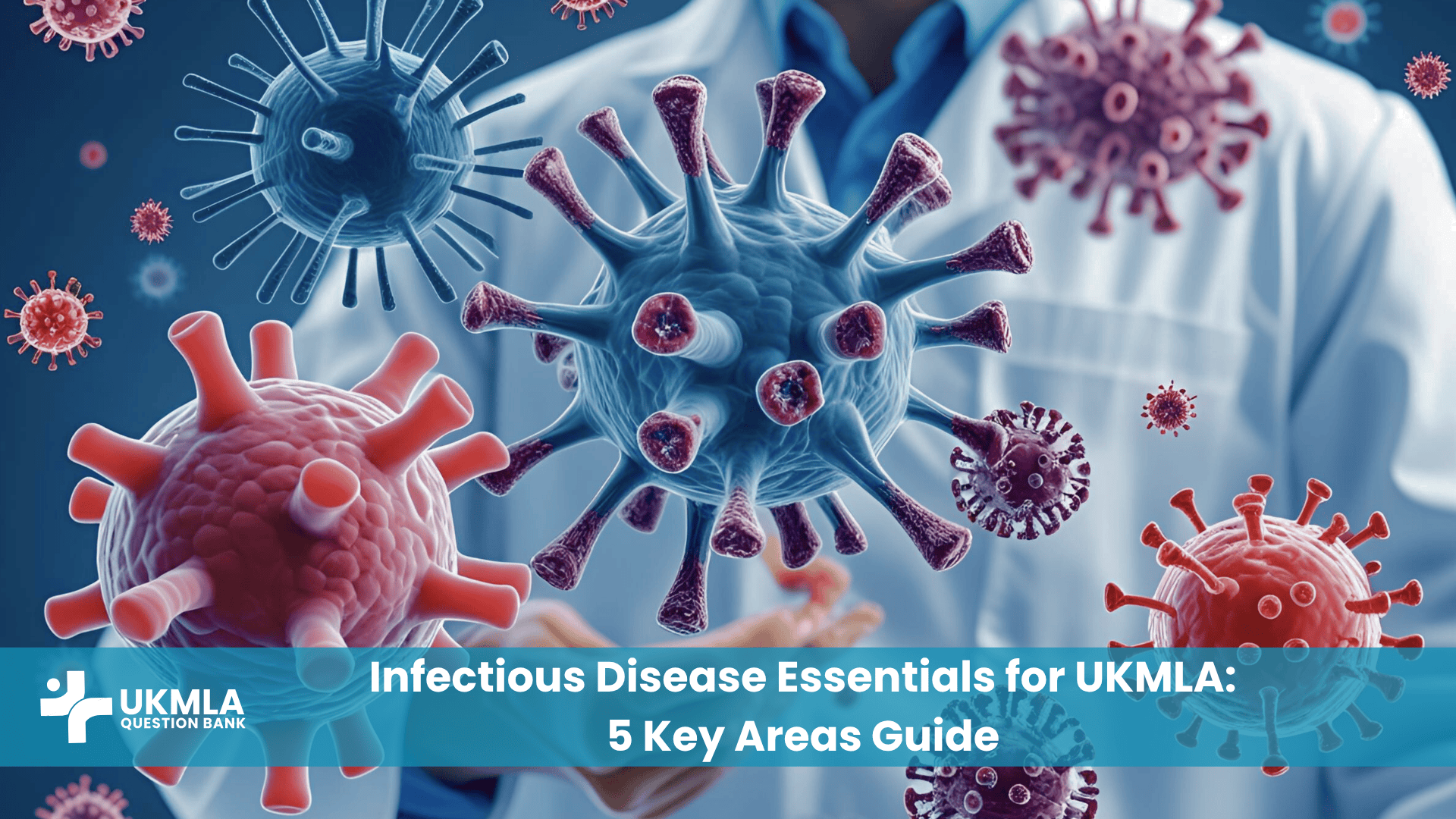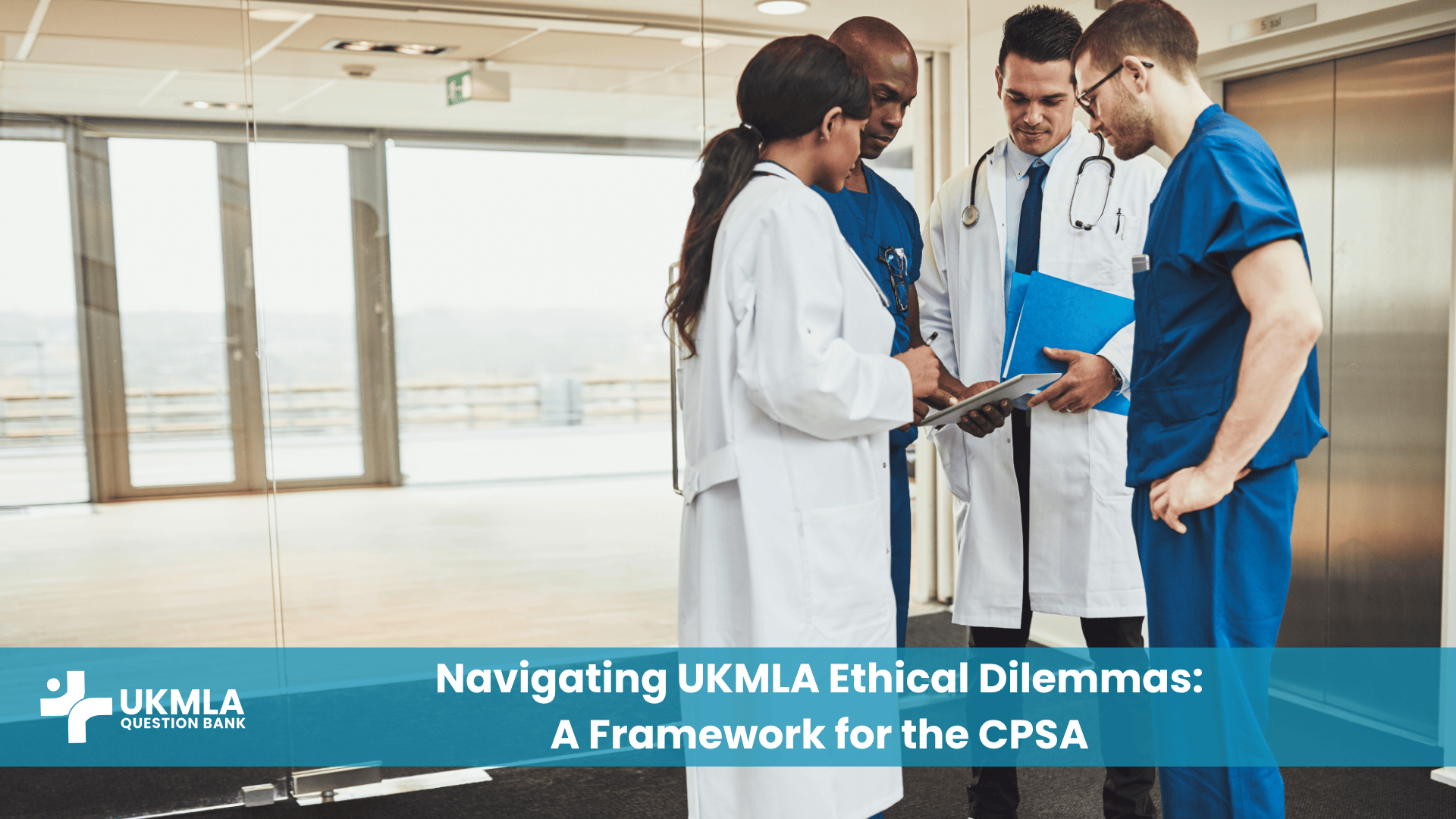Mastering the Infectious Disease essentials for UKMLA begins with a scenario every junior doctor knows well: it’s the middle of a busy on-call shift, and you’re called to review a patient with a fever and a high NEWS2 score. Your mind races through a vast sea of potential pathogens and an equally vast arsenal of antibiotics. Should you start with amoxicillin or co-amoxiclav? Is this a simple infection, or the beginning of life-threatening sepsis? This ability to think clearly under pressure and apply core principles of antimicrobial therapy is a cornerstone of safe medical practice and a frequent focus of the UKMLA.
The field of infectious diseases is enormous. It is impossible—and unnecessary—to memorise every rare pathogen or specialist antibiotic regimen. The UKMLA is designed to assess your competence as a Foundation Year doctor. It tests your understanding of core principles, your ability to recognise and manage common and critical infections, and your role within the UK’s public health framework.
This guide provides a structured approach to this vital topic. We will break down the 5 key high-yield areas you must master, from the fundamental principles of antibiotic stewardship to the management of specific viral illnesses and the recognition of notifiable diseases. This framework will help you organise your revision and build the confidence to tackle any infectious disease question the exam throws your way.
Key Takeaways
Stewardship First: Understanding how and when to use antibiotics safely is as important as knowing which one to prescribe. Always “Start Smart, Then Focus.”
Sepsis is a Time-Critical Emergency: You must be able to recognise the early signs of sepsis and initiate the “Sepsis Six” bundle within one hour. This is a non-negotiable standard of care.
Common Infections are Key: Focus your learning on the “bread and butter” infections seen daily in UK practice, such as community-acquired pneumonia, UTIs, and cellulitis.
Know Your High-Yield Viruses: Have a clear understanding of the presentation and initial management principles for key viral illnesses like HIV, influenza, and infectious mononucleosis.
Understand Your Public Health Duty: Recognise key notifiable diseases like tuberculosis and meningococcal disease, and know your responsibility to inform the correct authorities.
A Guide to the 5 Key Areas of Infectious Disease Essentials for UKMLA
1. Principles of Antimicrobial Stewardship & UK Guidelines
Before learning about specific bugs and drugs, you must understand the principles that govern their use. Antimicrobial resistance is a global health crisis, and antimicrobial stewardship is a professional responsibility for every prescriber in the UK. The UK’s approach can be summarised by the mantra “Start Smart, Then Focus.”
Start Smart: This means initiating prompt and effective antibiotic treatment for patients who are likely to have a bacterial infection, especially in cases of sepsis. Critically, this step involves taking appropriate cultures (e.g., blood cultures, urine cultures, wound swabs) before the first dose of antibiotics is given, provided this does not cause a significant delay in treatment. Your initial choice of antibiotic should be guided by local trust guidelines or the NICE guidelines, which take into account likely pathogens and local resistance patterns.
Then Focus: This is the review and decision-making step, typically occurring at 48-72 hours. By this time, you may have culture results and a clearer picture of the patient’s clinical response. The key questions to ask are:
Do the culture results guide a change in antibiotic (e.g., de-escalating from a broad-spectrum to a narrow-spectrum agent)?
Is the patient improving? Can we switch from intravenous (IV) to oral (PO) therapy?
Is an antibiotic still needed at all? Could this be a viral illness?
Have we prescribed the correct duration? A common error is prescribing excessively long courses of antibiotics.
Key Point: Always check local trust guidelines or the British National Formulary (BNF) before prescribing an antibiotic. While principles are universal, specific first-line choices can vary based on local resistance patterns, and it is crucial to follow local policy to ensure safe and effective treatment.
2. Recognising and Managing Sepsis
Sepsis is the single most important infectious disease emergency. It is a life-threatening organ dysfunction caused by a dysregulated host response to infection. Your ability to recognise and manage it promptly is a core professional competency.
Recognition: Early recognition is key. In the UK, the NEWS2 (National Early Warning Score 2) is used to track physiological observations and identify acutely unwell or deteriorating patients. A score of 5 or more is a key trigger to consider sepsis. However, do not rely on a score alone.
A Word from an Acute Medicine Consultant: “The patient with sepsis won’t always have a raging fever and low blood pressure. Sometimes the first sign is subtle confusion in an elderly patient or a rising respiratory rate. These ‘soft signs’ are critical. Learn to recognise them; trusting your gut and acting early on a suspicion of sepsis saves lives, and it is a core part of the Emergency Medicine Essentials for UKMLA.”
Management: The Sepsis Six Once sepsis is suspected, the “Sepsis Six” bundle must be delivered within one hour. This is a set of six interventions (three investigations and three treatments) that has been shown to significantly reduce mortality.
Give high-flow oxygen to maintain saturation levels.
Take blood cultures (and other relevant cultures).
Give broad-spectrum intravenous antibiotics according to local guidelines.
Give intravenous fluid resuscitation (a bolus of crystalloid).
Check lactate level (a marker of tissue hypoperfusion).
Monitor urine output accurately (often requiring catheterisation).
3. Common Community & Hospital-Acquired Infections
While sepsis is the most severe outcome, the UKMLA will expect you to know the standard management for common, uncomplicated infections. This is a core part of the Infectious Disease essentials for UKMLA. You should be familiar with the likely causative organisms and the standard first-line antibiotic choices as per UK guidelines.
Table 1: Common Infections: UK Pathogens & First-Line Antibiotics (NICE)
| Infection | Common Causative Organism(s) | Typical UK First-Line Oral Antibiotic | Key Considerations |
|---|---|---|---|
| Community-Acquired Pneumonia (CAP) | Streptococcus pneumoniae | Amoxicillin | Use CURB-65 score to assess severity. Doxycycline or clarithromycin are alternatives in penicillin allergy. |
| Uncomplicated UTI (in women) | Escherichia coli | Nitrofurantoin or Trimethoprim (if local resistance is low) | A 3-day course is usually sufficient. Avoid nitrofurantoin if eGFR is low. |
| Cellulitis | Streptococcus pyogenes, Staphylococcus aureus | Flucloxacillin | Use Eron classification to assess severity. Clarithromycin is an alternative in penicillin allergy. Elevate the affected limb. |
| Acute Otitis Media | Streptococcus pneumoniae, Haemophilus influenzae | Often viral; consider a delayed prescription for antibiotics (e.g., Amoxicillin). | Most cases resolve without antibiotics. |
4. Key Viral Illnesses: From HIV to Influenza
While antibiotics target bacteria, you must also have a strong grasp of common and important viral illnesses.
HIV: You are not expected to know specialist antiretroviral therapy. Instead, focus on the principles of consent for testing, confidentiality, and recognising common opportunistic infections in a patient with a low CD4 count (e.g., Pneumocystis jirovecii pneumonia, oesophageal candidiasis, cerebral toxoplasmosis).
Influenza: You should know the typical presentation (abrupt onset of fever, myalgia, headache) and understand that for most healthy individuals, treatment is symptomatic. Antivirals like Oseltamivir are reserved for “at-risk” groups (e.g., pregnant women, the elderly, immunocompromised individuals) to reduce the risk of complications like pneumonia.
Infectious Mononucleosis (Glandular Fever): Caused by the Epstein-Barr Virus (EBV), this commonly affects young adults. You must recognise the classic triad of fever, sore throat (with exudates), and lymphadenopathy. A key diagnostic clue is lymphocytosis with “atypical lymphocytes” on a blood film.
Key Point: The classic amoxicillin-induced rash in a patient with Infectious Mononucleosis is a frequently tested concept. If a patient with a severe sore throat and lymphadenopathy develops a widespread, itchy maculopapular rash a few days after being given amoxicillin, glandular fever should be your top differential diagnosis. This highlights the importance of distinguishing a viral from a bacterial sore throat.
5. Notifiable Diseases & Public Health Principles
As a doctor in the UK, you have a statutory duty to notify your local health protection team or Public Health England of certain infectious diseases. This is a legal and professional responsibility designed to prevent and control outbreaks. For the UKMLA, you should be able to recognise the clinical features of key notifiable diseases and understand the immediate actions required.
Table 2: Key Notifiable Diseases: Recognition & Action
| Disease | Core Clinical Features | Immediate Action Required |
|---|---|---|
| Tuberculosis (TB) | Persistent cough >3 weeks, haemoptysis, weight loss, night sweats, fever. | Isolate the patient in a negative pressure room (if inpatient). Start quadruple therapy (RIPE). Notify Public Health. Begin contact tracing. |
| Meningococcal Septicaemia | Fever, neck stiffness, photophobia, altered mental state, non-blanching purpuric rash. | This is a medical emergency. Give immediate parenteral antibiotics (e.g., IV Benzylpenicillin or Ceftriaxone). Urgent hospital admission. Notify Public Health. |
| Measles | Prodrome of fever, cough, coryza, conjunctivitis, followed by Koplik spots on buccal mucosa, then a descending maculopapular rash. | Isolate the patient. Provide supportive care. Notify Public Health. |
| Food Poisoning | An acute outbreak (2 or more cases) of gastroenteritis linked to a common food source. | Send stool samples for culture. Provide supportive care (rehydration). Notify Public Health. |
Frequently Asked Questions (FAQ) Your UKMLA Infectious Disease Questions Answered
CURB-65 is a clinical prediction rule used to assess the severity of community-acquired pneumonia and determine the need for hospital admission. It stands for Confusion, Urea >7, Respiratory rate ≥30, Blood pressure <90 systolic or ≤60 diastolic, and Age ≥65.
A delayed or “back-up” prescription is a strategy used in antimicrobial stewardship, particularly for self-limiting infections like acute otitis media or sinusitis. The patient is given a prescription that they are advised to cash only if their symptoms do not improve after a set period (e.g., 72 hours).
RIPE is a mnemonic for the standard four-drug initial treatment regimen for active TB: Rifampicin, Isoniazid, Pyrazinamide, and Ethambutol.
The most common bacterial cause of traveller’s diarrhoea worldwide is Enterotoxigenic Escherichia coli (ETEC).
Latent TB means a person is infected with the Mycobacterium tuberculosis bacteria, but it is dormant and they have no symptoms and are not infectious. Active TB is when the bacteria are multiplying, causing symptoms, and the person is infectious.
Koplik spots are a pathognomonic sign of measles. They are small, white spots (like grains of salt) on a red background that appear on the buccal mucosa (inside of the cheeks) during the prodromal phase of the illness.
No. Trimethoprim is a folate antagonist and should be avoided in the first trimester of pregnancy due to its association with neural tube defects. Nitrofurantoin is often a preferred choice in early pregnancy.
The glass test is a way to check if a rash is non-blanching, a key feature of meningococcal septicaemia. You press a clear glass firmly against the rash. If the rash does not fade under the pressure, it is non-blanching and is a medical emergency.
C. difficile is a bacterium that can cause severe, antibiotic-associated diarrhoea and colitis. It is most common in elderly hospital patients who have received broad-spectrum antibiotics, which disrupt the normal gut flora.
An antiseptic (e.g., chlorhexidine) is used on living skin or tissue to inhibit or kill microorganisms. A disinfectant (e.g., bleach) is used on inanimate objects or surfaces to kill microorganisms.
Conclusion
The field of infectious diseases is dynamic and challenging, but your preparation for the UKMLA can be focused and systematic. By mastering these five key areas, you build a powerful framework for success. Understand the core principles of antimicrobial stewardship, be able to act decisively in the face of sepsis, know your common “bread and butter” infections, recognise high-yield viral illnesses, and be aware of your crucial public health responsibilities.
This principles-based approach, grounded in the realities of UK clinical practice, is the essence of what the exam assesses. By focusing on these Infectious Disease essentials for UKMLA, you will not only be preparing to pass the test but also building the foundational knowledge required to be a safe, competent, and responsible doctor. To put this knowledge to the test, explore how these scenarios appear in a UKMLA Question Bank: An Essential Resource for Medical Aspirants.
Call to Action:
Infectious diseases often present as acute emergencies. Solidify your understanding of managing unwell patients by reading our guide on Emergency Medicine Essentials for UKMLA: Critical Presentations & (AKT & CSPA) Focus.



